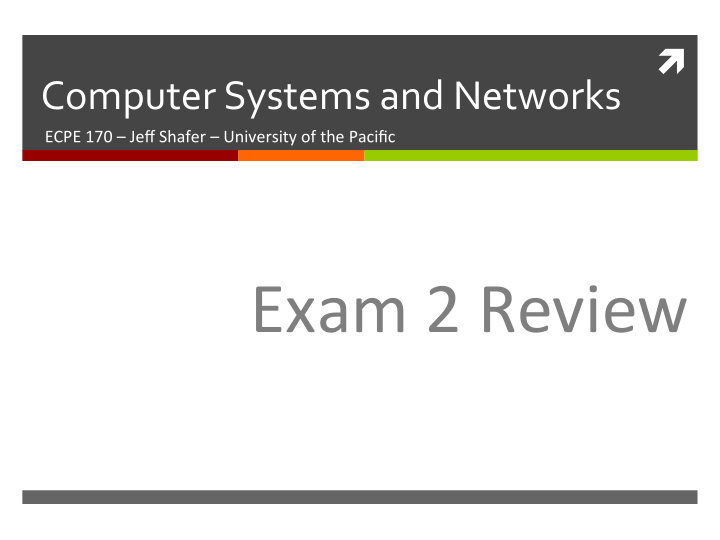



ì ¡ Computer ¡Systems ¡and ¡Networks ¡ ECPE ¡170 ¡– ¡Jeff ¡Shafer ¡– ¡University ¡of ¡the ¡Pacific ¡ Exam ¡2 ¡Review ¡
2 ¡ Exam ¡2 ¡ ì Similar ¡format ¡as ¡last ¡Ame ¡ ì Closed ¡notes, ¡closed ¡book, ¡no ¡calculator, ¡etc… ¡ ì I ¡will ¡provide ¡Table ¡4.7 ¡ ¡(MARIE ¡ISA) ¡ ì Chapter ¡4 ¡– ¡On ¡the ¡exam! ¡ ì Chapter ¡5 ¡– ¡On ¡the ¡exam! ¡ Computer ¡Systems ¡and ¡Networks ¡ Spring ¡2012 ¡
3 ¡ Review ¡Materials ¡ ì Things ¡to ¡study ¡ Homework ¡assignments ¡ ì ì SoluLons ¡are ¡posted ¡in ¡Sakai ¡ Quiz ¡3 ¡and ¡4 ¡ ì ì SoluLons ¡are ¡posted ¡in ¡Sakai ¡ Lecture ¡notes ¡ ì ì QuesAon ¡format ¡will ¡be ¡similar ¡to ¡quizzes ¡ Mix ¡of ¡problems ¡and ¡short ¡answer ¡quesAons ¡ ì Problems ¡typically ¡come ¡from ¡textbook… ¡ ì Short ¡answer ¡ques:ons ¡typically ¡come ¡from ¡lectures… ¡ ì Computer ¡Systems ¡and ¡Networks ¡ Spring ¡2012 ¡
4 ¡ ì ¡ Chapter ¡4 ¡– ¡Computer ¡Organization ¡ Computer ¡Systems ¡and ¡Networks ¡ Spring ¡2012 ¡
5 ¡ Exam ¡2 ¡ ì Chapter ¡4 ¡Topics ¡ ì Basic ¡computer ¡organizaAon ¡ ì MARIE ¡architecture ¡ ì Major ¡components ¡and ¡operaAon ¡ ì MARIE ¡programs ¡ ì “Write ¡a ¡complete ¡program ¡that ¡does ¡XYZ” ¡ ì SubrouAnes, ¡indirect ¡instrucAons, ¡etc.. ¡ Computer ¡Systems ¡and ¡Networks ¡ Spring ¡2012 ¡
6 ¡ Computer ¡Organization ¡ ì What ¡is ¡a ¡bus? ¡ ì What ¡does ¡the ¡ clock ¡do? ¡ ì Is ¡increasing ¡the ¡clock ¡rate ¡the ¡only ¡way ¡to ¡ improve ¡applicaLon ¡performance? ¡ CPU Time= seconds program = instructions program * avg.cycles instruction *seconds cycle Reduce ¡any ¡of ¡these, ¡or ¡all ¡three! ¡ Computer ¡Systems ¡and ¡Networks ¡ Spring ¡2012 ¡
7 ¡ Computer ¡Organization ¡ ì What ¡does ¡ addressability ¡mean ¡in ¡the ¡context ¡of ¡a ¡ memory ¡system? ¡ ì Which ¡type ¡of ¡memory ¡system ¡would ¡require ¡ more ¡address ¡lines ¡to ¡access ¡the ¡same ¡number ¡of ¡ bytes: ¡a ¡ word-‑addressable ¡ memory, ¡or ¡a ¡ byte-‑ addressable ¡ memory? ¡ ì What ¡is ¡the ¡difference ¡between ¡ high-‑ord er ¡and ¡ low-‑order ¡ interleaving? ¡ ¡(What ¡is ¡interleaving?) ¡ Computer ¡Systems ¡and ¡Networks ¡ Spring ¡2012 ¡
8 ¡ Memory ¡Organization ¡ ì Exercise: ¡ ¡Build ¡a ¡1M ¡x ¡16 ¡word-‑addressable ¡main ¡ memory ¡using ¡128K ¡x ¡4 ¡RAM ¡chips. ¡ How ¡many ¡address ¡bits ¡are ¡needed ¡per ¡RAM ¡chip? ¡ 1. How ¡many ¡RAM ¡chips ¡are ¡there ¡per ¡word? ¡ 2. How ¡many ¡RAM ¡chips ¡are ¡necessary? ¡ 3. How ¡many ¡address ¡bits ¡are ¡needed ¡for ¡all ¡memory? ¡ 4. How ¡many ¡address ¡bits ¡would ¡be ¡needed ¡if ¡it ¡were ¡byte ¡ 5. addressable? ¡ How ¡many ¡banks ¡will ¡there ¡be? ¡ 6. What ¡bank ¡would ¡contain ¡address ¡47129 16 ¡with ¡(a) ¡high-‑ 7. order ¡interleaving ¡or ¡(b) ¡low-‑order ¡interleaving? ¡ Computer ¡Systems ¡and ¡Networks ¡ Spring ¡2012 ¡
9 ¡ Solution ¡to ¡Exercise ¡ Each ¡RAM ¡chip ¡has ¡128K ¡locaAons: ¡ ¡ ¡2 7 ¡* ¡2 10 ¡= ¡ 17 ¡bits ¡ 1. Each ¡RAM ¡chip ¡locaAon ¡stores ¡4 ¡bits, ¡but ¡we ¡need ¡16: ¡ ¡ 2. ¡ 4 ¡chips ¡needed ¡per ¡word ¡ 1. Each ¡RAM ¡chip ¡has ¡128K ¡locaAons, ¡but ¡we ¡need ¡1M ¡locaAons: ¡ ¡ 3. ¡1M/128K ¡= ¡8 ¡(Ames ¡4 ¡chips ¡per ¡word) ¡= ¡ 32 ¡RAM ¡chips ¡(8 ¡rows, ¡4 ¡columns) ¡ 1. Memory ¡is ¡1M: ¡ ¡2^20 ¡= ¡ 20 ¡bits ¡for ¡all ¡of ¡memory ¡ 4. Byte ¡addressable ¡adds ¡1 ¡more ¡bit ¡here ¡(to ¡select ¡either ¡the ¡lower ¡8 ¡or ¡upper ¡8 ¡of ¡the ¡16 ¡bit ¡long ¡ 5. word): ¡ ¡ 21 ¡bits ¡ 8 ¡banks ¡of ¡memory, ¡where ¡each ¡bank ¡has ¡4 ¡chips ¡ 6. Address ¡is ¡20 ¡bits ¡long, ¡bank ¡is ¡upper ¡3 ¡bits ¡(2^3=8): ¡ 7. 47129(16) ¡= ¡0100 ¡0111 ¡0001 ¡0010 ¡1001 ¡(2) ¡ With ¡high-‑order ¡interleaving, ¡bank ¡is ¡ #2 ¡ With ¡low-‑order ¡interleaving, ¡bank ¡is ¡ #1 ¡ Computer ¡Systems ¡and ¡Networks ¡ Spring ¡2012 ¡
10 ¡ MARIE ¡Components ¡ ì AC? ¡ ì PC? ¡ ì IR? ¡ ì ALU? ¡ ì MAR? ¡ ì MBR? ¡ Computer ¡Systems ¡and ¡Networks ¡ Spring ¡2012 ¡
11 ¡ ì ¡ Chapter ¡5 ¡-‑ ¡ISA ¡ Computer ¡Systems ¡and ¡Networks ¡ Spring ¡2012 ¡
12 ¡ Exam ¡2 ¡ ì Chapter ¡5 ¡Topics ¡ Endianness ¡ ì Infix ¡and ¡posfix ¡notaAon ¡ ì Memory ¡addressing ¡modes ¡ ì Pipelines ¡(concept, ¡speedup, ¡hazards) ¡ ì InstrucAon ¡sets ¡ ì ì 0-‑address ¡machines ¡(i.e. ¡stack ¡machines) ¡ ì 1-‑address ¡machines ¡(i.e. ¡accumulator ¡machines) ¡ ì 2-‑address ¡and ¡3-‑address ¡machines ¡(general ¡purpose ¡ register ¡machines) ¡ 7 ¡different ¡instrucAon ¡types ¡(data ¡movement, ¡arithmeAc, ¡ ì etc…) ¡ Computer ¡Systems ¡and ¡Networks ¡ Spring ¡2012 ¡
13 ¡ Pipeline ¡Hazards ¡ ì In ¡computer ¡architecture, ¡hazards ¡are ¡opportuniAes ¡ for ¡data ¡corrupAon ¡and ¡incorrect ¡calculaAons ¡if ¡a ¡ naïve ¡pipeline ¡design ¡does ¡not ¡detect ¡specific ¡error ¡ condiAons ¡and ¡accommodate ¡them, ¡potenAally ¡by ¡ introducing ¡delays ¡("stalls") ¡in ¡the ¡pipeline. ¡ ¡ ì What ¡is ¡a ¡ ì Data ¡hazard? ¡ ì Structural ¡hazard? ¡ ì Control ¡hazard? ¡ ¡ Computer ¡Systems ¡and ¡Networks ¡ Spring ¡2012 ¡
14 ¡ 50 ¡word ¡Problem ¡ ì Data ¡hazards ¡represent ¡obstacles ¡prevenAng ¡ perfect ¡parallel ¡execuAon ¡of ¡instrucAons, ¡such ¡as ¡ when ¡one ¡instrucAon ¡depends ¡on ¡a ¡result ¡produced ¡ by ¡a ¡previous ¡instrucAon ¡that ¡has ¡not ¡yet ¡finished ¡ ( a ¡data ¡hazard ), ¡when ¡mulAple ¡instrucAons ¡rely ¡on ¡ the ¡same ¡hardware ¡element ¡like ¡a ¡shared ¡memory ¡ ( a ¡structural ¡hazard ), ¡or ¡when ¡the ¡next ¡pipeline ¡ instrucAon ¡cannot ¡be ¡immediately ¡determined ¡due ¡ to ¡a ¡yet-‑unresolved ¡branch ¡( a ¡control ¡hazard ). ¡ ¡ ¡ ì 66 ¡words ¡ Computer ¡Systems ¡and ¡Networks ¡ Spring ¡2012 ¡
Recommend
More recommend